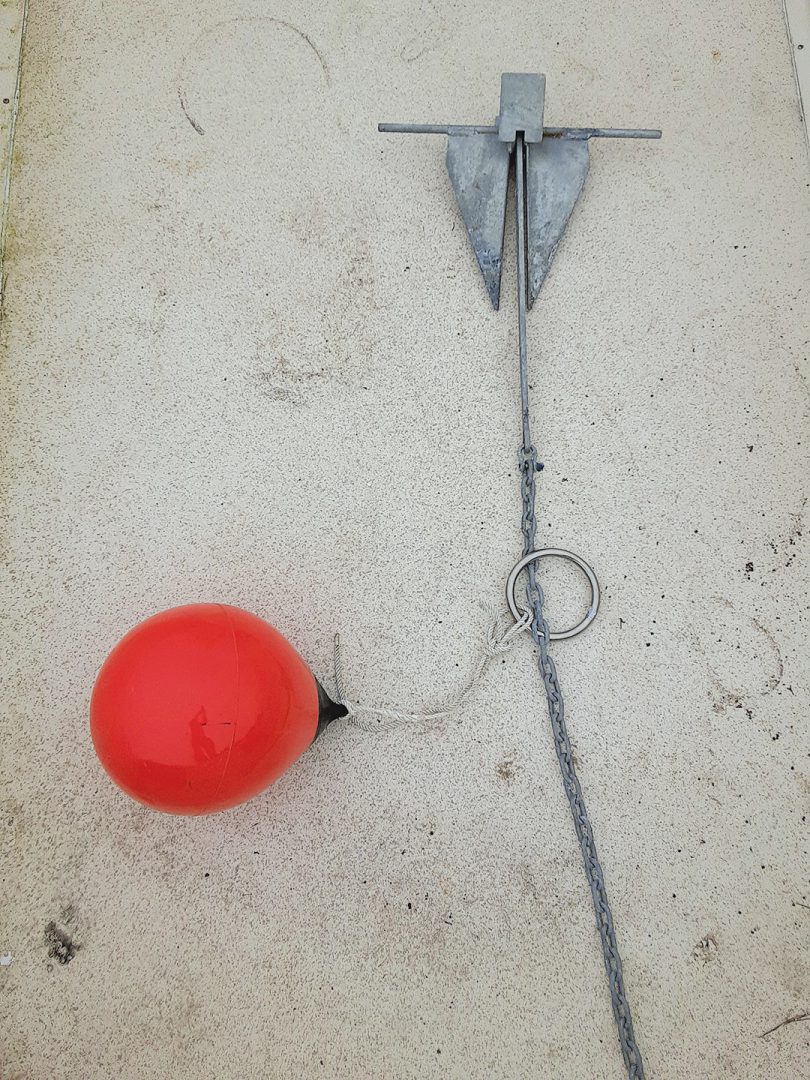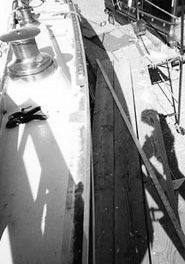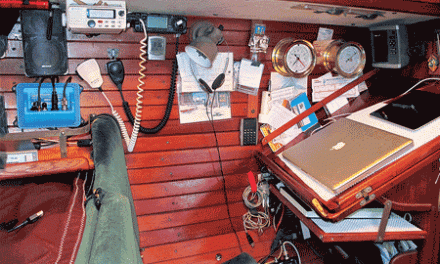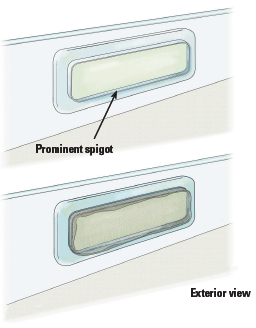No windlass? No problem with this nifty, time-tested, anchor ring hack.
Issue 138: May/June 2021
In high school, I worked as a deckhand on a charter fishing boat. Bottom fishing for cod in the Gulf of Maine with rod and reel, we routinely anchored 15 to 20 miles offshore in depths up to 200 feet.
Keeping the boat in place took a lot of scope. There was no windlass aboard; when it was time to weigh anchor, the captain would send me and another teenaged crew forward. Fortunately, my crewmate and I spent less time straining and grunting and more time managing a simple anchor retrieval ring that effected all the heavy lifting.
It’s one of many clever tricks I learned on that job, and it can come in handy when you don’t have a windlass.

Attached to a properly sized buoy, the anchor ring allows the rode to slide through during anchor retrieval.
All you need is an anchor ring (also known as an anchor lift ring, anchor retrieval ring, or anchor puller ring), attached with a short piece of line to a buoy or fender. The ring is simply a stout galvanized or stainless steel ring that can range from 4 to 8 inches in diameter, depending on anchor size. Some rings are split and can be attached to the rode when it’s time to weigh anchor; others, like the one I use, is a solid ring. The buoy or fender needs enough buoyancy to support the weight of the anchor plus the chain—a 14-inch-diameter buoy, for example, will support 60 pounds.
Here’s how it works: When I deploy the anchor, I have already set it up so that the rode will run through the anchor ring. As I deploy (and while anchored), the ring and buoy stay onboard, secured on deck. I set the anchor normally, the only difference being that the rode is traveling through the anchor ring.
When it’s time to weigh anchor, I slide the ring and buoy down the rode into the water. I make the rode fast to a cleat, snubber, or chain stopper. Then, I motor ahead at an angle of about 45 degrees away from the rode (this keeps the rode clear of the keel, prop, and rudder). At this heading, the boat isn’t pulling on the rode. The rode is simply falling away to the side and gaining slack, and the buoy is also falling to the side as we motor away from it.
Once the boat passes the spot where the anchor is set, I start to turn in a wide arc around the anchor, the radius of which is approximately equal to the length of the rode. As I do this, the buoy’s drag resistance causes it to stay put while the boat pulls the rode through the ring. And because the buoy’s buoyancy prevents it from being pulled under, the rode is lifted and scope decreases. By the time the pull on the anchor becomes nearly vertical, that pull is in about the opposite direction at which the anchor is set, and the anchor pops free. (By now, the boat is a fair distance from the buoy as I continue traveling in my arc.)
Once the anchor is free, the rode continues running through the ring as the buoyancy of the buoy lifts the anchor off the bottom (this is why you need a buoy that can support the weight of the anchor and chain).
When the anchor meets the ring, the shank slides through it, but the flukes/spade get caught. At this point, the buoy does a telltale hop and the anchor sits cradled in the ring, the weight of the chain preventing the anchor from tipping forward and falling back out. Now, the boat can slow down and turn toward the buoy, allowing the crew to retrieve the slack rode easily by hand. The full weight of the anchor and chain is off the seafloor and at or near the surface, hanging under the buoy.

Anchor rings work best with a combination rope/chain rode in which the weight of the chain exceeds that of the anchor. Anchor rings also require plenty of space in the anchorage to maneuver. This method works particularly well with Fortress- and Danforth-type anchors but will work with most anchors as long as the shank fits through the ring, the chain weighs more than the anchor, and the buoy has a rated buoyancy that exceeds the combined weight of the anchor and chain.
On that charter fishing boat, we performed this evolution up to four times a day with a 45-pound Danforth anchor, 40 feet of chain, and total rode length of up to 1,000 feet. The ring was 6 inches in diameter, and we used a 27-inch ball-shaped buoy.
On Fulmar, the boat I sail today, our primary anchor is a 44-pound spade with 75 feet of chain. Because of the width of the spade’s shank, we use an 8-inch-diameter stainless steel ring with two or three large fenders.
Welded stainless steel or galvanized rings can be purchased online and at chandleries that cater to commercial fisheries. A large stainless ring usually costs less than $20, galvanized is cheaper. You can purchase rings specifically marketed for anchor retrieval, but most of the ones I have seen appear too flimsy for anchors over 15 pounds.
We only retrieve the anchor this way sometimes, just to make sure we could do it if our windlass fails. Using an anchor ring isn’t as quick or easy as using a windlass, but it’s much easier than muscling the hook and chain off the bottom by hand.
Damon Gannon is a marine biologist who has conducted research on marine mammals, fishes, and seabirds from the Gulf of Mexico to the Bay of Fundy. He is assistant director of the University of Georgia Marine Institute on Sapelo Island. He and his wife, Janet, sail Fulmar, their Pacific Seacraft 37, out of Brunswick, Georgia.
Thank you to Sailrite Enterprises, Inc., for providing free access to back issues of Good Old Boat through intellectual property rights. Sailrite.com





